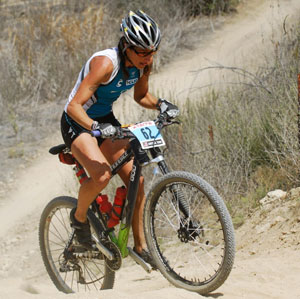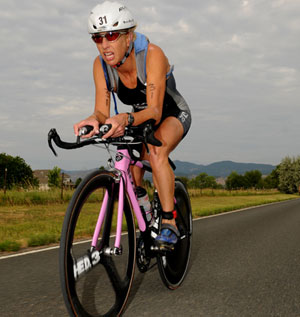Jamie Whitmore’s greatest victory
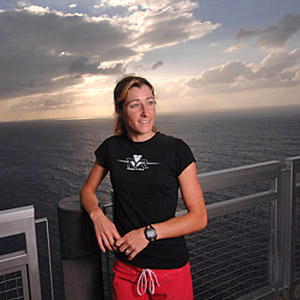
Jamie Whitmore was quite a vision skittering on the skinny single track along the Flume Trail overlooking the azure depths of Lake Tahoe, and charging down the precipitous declivity of Tunnel Creek Road like Picabo Street’s skinny kid sister. At the Xterra National Championships in Tahoe, she had that magic touch that allowed her to fly untouched past immovable trees and twixt sharp rocks and roots and lumps in the ground like the Star Wars Ewoks zipping through George Lucas's magical woods. Impossible to forget her twin pigtails bobbing back beneath her helmet, determined focused eyes wide like saucers behind her goggles, freckles surrounding her gritting teeth in mid-race. Then that same mouth would be laughing with joy at any excuse before and after the battle. Hard to forget that she virtually owned Xterra Tahoe, winning the USA championship there in 2002, 2003, 2004 2005 and 2007.
Jamie was quite a vision in more tropical climes, too. She ran like a mountain goat through the jungles in Saipan and Guam, always sure footed picking her way on steep stone cliffs in waterfalls, tripping through slick wet jungle trails with cool-eyed concentration on her way to a still standing Xterra record 37 wins which stands almost 10 better than Conrad Stoltz’s record as the best pro man on Xterra Planet.
And, like Mark Allen and Dave Scott, Muhammad Ali and Joe Frazier, Federer and Nadal, Jamie gained her greatest renown vying with rival Melanie McQuaid in a series of Xterra duels for the ages. While Jamie had Melanie’s number five years out of six at Tahoe (5 wins to 1), McQuaid took Whitmore’s measure at the Xterra Worlds in Maui four times to two, three wins to one. Like in the best of those rivalries, they raised one another’s game to legendary status.
Suddenly, like a bolt of lightning raining down from the sky or a meteor crashing to earth, that chapter was closed. Jamie Whitmore was hit by a rare and particularly virulent form of cancer that presented an even greater challenge than faced by Lance Armstrong, Karen Smyers, hockey star Mario Lemieux, baseball player John Kruk and Olympic wrestler Jeff Blatnick. Detected in early 2008, Whitmore’s spindle cell sarcoma wrapped itself around her sciatic nerve, and required removal of her left gluteus, the engine that powered her swift-as-a-deer legs so effortlessly for an 8-year professional triathlon career.
No matter how tough it was to cover thousands of miles of training runs and rides, and to push her willing body to the limit up oxygen poor mountain hills, and through wicked humid jungle heat, this was nothing compared to the sheer pain of the four operations that saved her life but took away her sport, her profession, the life she knew and loved. While Armstrong recovered from his cancer and went on to win seven Tours de France, and Smyers, Kruk, Blatnick and Lemieux went on to play at the highest levels of their sports, Jamie Whitmore does not have that option.
Instead, you can find her at her gym. She is the one who wears a pink sweatband around her ankle that says “cancer sucks” and somehow working a glute machine — without a glute. Now she is busier than ever, making motivational speeches, coaching athletes, announcing at races, and schemes and dreams how to retain the greatest degree of physical freedom. She maintains a fund for victims of Huntington’s Disease that afflicted members of her family, counsels and consoles fellow cancer–sufferers, and still has that infectious laugh, most often aimed at herself and her plight.
Like many cancer survivors, she wants to set an example for anyone who get discouraged by the fight to live and transcend cancer. “A lot of people in our sport heard about my cancer at first,” she says. “But I don’t think they know the whole story and I’d like to share it.”
In this oral history of her fight with cancer, Jamie doesn’t pull any punches or shy away from the intimate personal toll. So it’s not an easy read. But it’s worth it if you have the courage.
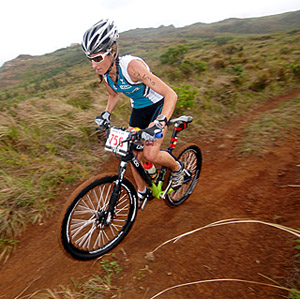
PART ONE: WHEN THE CANCER HIT
I first noticed a symptom that something was wrong at 2007 Xterra Worlds in Maui. There was no way they could have guessed what it was.
My leg did not feel right. I had really severe cramping issues on the bike. All I could think about was getting to the finish line. I did my best and I finished third. I’ve had some big wins feeling bad. But looking back I think, ‘Oh my gosh, I can’t believe I ran through something that painful.’
For the next few months I ran off and on. Every time I tried to run, my hamstring felt tight and hurt severely. As soon as I walked, I was totally fine. The pain extended from my hamstring to my upper calf.
Then I started noticing some numbness. Again, I thought I must have pulled or torn something. I would stop running for a few weeks but continued to swim and bike. I thought I just really hurt myself. I had never had an injury that persistent. I never knew how serious it might be. I was an athlete and we are used to training through the pain.
I could still cycle and swim with no symptoms at all. That went on until the end of January 2008 when I tried to run one last time at a training camp. Five minutes into the run, my whole leg felt incredibly painful.
That night, for the first time, the pain kept me up all night. Looking back I understand why I couldn’t sleep. Your brain cannot shut out that type of pain. Five days later, I tried to cycle. For the first time while riding it was so painful I cried the whole ride. I turned around after 15 minutes of a planned one hour spin. It was so painful I knew I needed to talk to someone.
TOUGH DIAGNOSIS
First doctor I saw I got an MRI and X-ray of my lower spine. He thought I had a ruptured disc or tendinitis. I told the doctor there is no way this is tendinitis because I have not been doing anything that would have caused that.” He thought I should take time off and my tendinitis would get better. I knew that was not the case because it would have already gotten better. So maybe it had to do with a ruptured disc. It was most excruciating when I lay completely flat. When I got the MRI they made me lay flat and still. My eyes started tearing it was so painful, and they didn’t find anything.
Then the numbness started to spread all through my left leg. I had numbness when I went to the bathroom and that started to send up a red flag. A doctor I knew told me, “Go to the emergency room
and demand a CT scan of the abdominal area!” So I went to the emergency room February 7. 2008.
ER FOLLIES
The first emergency room I went to was a very bad experience. The doctor treated me as if I was in there seeking drugs. He kept saying it was just an overuse injury, that I probably have sciatic nerve issues. I’d been there 6 hours and they didn’t do anything. Reluctantly, he said “I guess I can take
a CT scan.” But I knew he would make us wait even longer and I was starving and in some serious pain. I just wanted to go home where I could cry privately and not deal with people who didn’t want to help me. It was frustrating! If the doctor had just done a CT scan and not been a jerk… they
probably would have caught the thing a week earlier and the next few weeks would not have been wasted.
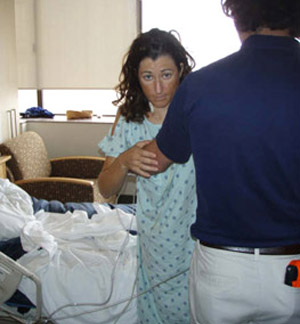
ANOTHER MISDIAGNOSIS
The next day we told the doctor we knew that we never got the CT scan. He couldn’t believe it and got upset with us. He urged us to go to a different hospital and figure out what’s going on. The next day Courtney drove me to another emergency room an hour and a half away from our house. After several more hours of waiting I was seen and explained what was going on. Immediately the doctor said “Wow, you're an athlete and in this much pain. It must be really serious.”
He looked at my left foot, which was already exhibiting slight drop foot. When I explained where all the numbness was he agreed to get a CT scan of my abdominal area. I had to wait several more hours
because so many people were there for things like car accidents. Saturday is a big day in the ER!
Finally I got the scan. Another doctor evaluated it and said “Looks like a large mass, perhaps a cyst on the ovary. Hang on and we will do an ultrasound.” We waited around and they did an ultrasound. Then another doctor came in and he was convinced it was an ovarian cyst. He wanted me to go to my OB-GYN immediately. He even called me the next morning to make sure I was going to make an appointment.
I was not convinced he was right. There was no pain even when someone pushed on my abdominal area. Not one single flinch. But I made the appointment anyway.
It took me a couple days to go to my regular doctor to get a referral to see an OB-GYN. When I got an appointment, I took the discs with all my scans and all my X-rays on a DVD, but no one would look at them. They all took the word of what the ER doctor said in my file. They persisted in wanting to treat it like an ovarian cyst. That is until the OB-GYN doc did a physical exam and realized the mass was too hard. He then referred me to an ovarian cancer specialist.
FOURTH DOCTOR ON TARGET
The ovarian cancer specialist did another exam. He though the same thing without saying it. He wanted to do a laparoscopy – which is not very invasive. They make two small incisions and take a tiny sample of the large mass to test. At this time they did not call it a tumor. The doctor was only supposed to go in and take a small sample. It should have taken a couple of hours, not an overnight thing. But he found that the mass was encrusted by blood vessels growing around it when he took a piece. I started to bleed really badly so they cut me open to stop it.
They were unable to get a proper sample. That was a good thing as it turned out. Later
on they discovered the tumor looked squishy and could burst, causing the cancer to spread throughout my body.
I couldn't get mad. I ended up being hospitalized to figure out the next course of action. At this point they still didn’t know where it originated or if it was cancer.
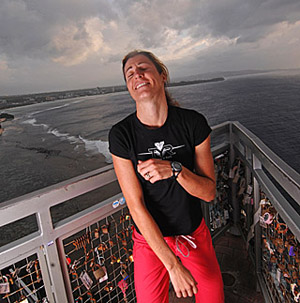
SACRAMENTO’s DR. HOUSE
I was referred to yet another specialist, the best in Sacramento. This was a rare case, a case for the TV show House. And that doctor in Sacramento was a dead ringer for TV’s Dr. House. He had no manners and no compassion. I was with my dad and Courtney while he said, “Yeah this is a pretty big tumor. 10 or 20 years ago we would amputate that leg. If I go in to remove it I may have to take out part of your rectum, colon and/or large intestine.”
I was sitting there thinking: Are you kidding me? I started crying. I heard nothing after that. Luckily Courtney and my dad were there to listen. My dad asked the doctor if this were you, what would you do? He immediately replied, “Get a second opinion.”
He recommended going to the MD Anderson Cancer Center in Texas, one of the best in the country. But a friend of ours who worked with removing benign nerve tumors at UCSF convinced us to come to San Francisco. He had been trying to get us to come down there for at least two weeks. At the time I was in too much pain to fly anywhere and I knew deep down inside I needed to go where there were very, very good nerve doctors. I knew this had more to do with nerves than cancer.
SAN FRANCISCO SARCOMA SPECIALIST TO THE RESCUE
I remember the drive to San Francisco in late February 2008 very vividly. The sarcoma doctor was not usually there on Fridays. Our friend did us a big favor and pulled some strings. For the entire drive Courtney recalled I was screaming the whole time. I was in and out of it because I was so delirious and tired. The people who talked to Courtney on the phone could not believe it was me screaming in the background. Courtney’s dad said if this were a dog, I’d have shot him and put him out of his misery.
When I got to San Francisco, the doctor realized it was pretty bad and I was in a lot of pain. They admitted me to the hospital to get the pain under control. At this point, I was barely able to talk. I couldn’t straighten my leg and it was already in atrophy. Standing or putting any weight on it at all was difficult. The only thing I could do was lay with my leg out to the side. I was bedridden!
MAJOR PAIN
It took a while to get the pain under control. They tried lots of stuff and ended up with a good concoction. On a scale of 1-10, the pain was easily a 20. The combination of drugs brought it to an eight. For the next 10 days to two weeks, the doctors kept trying to take a biopsy of the tumor to figure out what it could be. Doctors don’t like to wing it. They like to be prepared for everything. The problem was that the tumor looked too squishy from every angle. They were able to get a needle biopsy but didn’t really share the results with me. I think all along they knew it was cancer, but they didn’t want to alarm me without more information. I eventually found out when they sent in radiation and chemotherapy doctors to prepare me for what the next step might be after surgery. On March 28, 2008 I was scheduled for major surgery for the first time.
LIVING IT UP PRE-OPERATION
Just before the operation, the owners of Fleet Feet Sacramento, Pat Sweeney and his wife Jan, made me Easter dinner and brought it over to my house. We had been living with my dad, Biff Whitmore, who did everything he could for me when this all started. Dad would take care of me during the daytime because Courtney could not go to work knowing I wasn't taken care of. This way he could focus better on things that needed his undivided attention. Courtney had an Easter egg hunt for me. I could not get out of bed, but I'd point and Courtney would walk around looking in the exact spot I told him to.
My mother–in-law made a really cool Easter bicycle basket. It was a wrought iron planter stand but she filled it with all kinds of Easter candy and put a stuffed bunny on the bike seat. It was awesome. I wanted to live it up before I went into surgery. You never know going into any type of surgery.
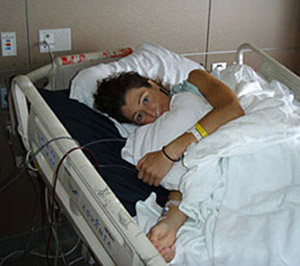
FOUR DOCTORS AND AN OPERATION
For my surgery I had four doctors present. They covered all the bases. I had a nerve doctor, the sarcoma doc, a colon guy (a gastroenterologist specialist in case the tumor was attached to some vital organs) and the radiation doc to hit me with a high dose when the tumor was out. Sarcomas (which is what my tumor was classified) are pretty rare cancers, so they wanted to make sure it didn't come back or spread. The most common and first place they usually spread is to the lungs.
They knew there was a tumor growing from my glute through the pelvic bone and pressed up against all sorts of vital organs – the rectum, the uterus, bladder, large intestine — and they were very worried if the tumor were attached to any of those they might have to cut some of that away.
Here is the deal. With cancer the doctors like to remove a large margin around the tumor to make sure there are no cancer cells left. With me, that was not really possible because the whole margin was encased in vital stuff. That would have meant removing crucial parts of important organs.
Going into the operation, I realized my leg was pretty messed up and something might happen and I would not be able to walk. The doctors told me that there was a risk I would not be able to have kids because of the radiation.
I was in so much pain and I know things were really bad, but what was really important to me was to make sure I was able to go to the bathroom on my own. No colostomy bag. No catheter. When I would emphatically repeat my stand, the doctors would laugh with me. “Jamie, we understand your priorities.”
BREAKING THE BAD NEWS
I woke up from my surgery and nobody wanted to break the news that they had removed most of the sciatic nerve and I would probably never be able to use my foot again. I think their attitude was: If there was a small chance that this would not be the case, let’s be positive and wait and see what happens. I had a real positive attitude. In reality, I'll probably never walk again without a brace, but your body does miraculous things and is able to compensate when things go wrong. So I am hopeful.
JAMIE’S DAD AND HUSBAND STAR IN JAMIE’S POST-OP BLUES
After the surgery I could not even take a step. My leg had atrophied so long I had to relearn to walk. It was so bad the physical therapist suggested I go to a special rehab home because I still hadn't made much progress. The next two days over the weekend, I asked my Dad to walk me as much as possible. I just wanted to go home. My home. After two days, sure enough I was walking with a walker.
My dad was staying in the hospital with me 24-7. He would help me get out of bed. Nurses were busy, it was easier for him to help and he would get me Jamba Juice every day! He was a hero. Oh yeah, definitely! He was a rock star, helping me until I was able to walk on my own.
All the nurses cheered for me. "Wow this is your third time around." What’s even neater, I still did not have a brace for my foot. I was supposed to have a special drop foot brace made but my leg was too swollen. So for the time being we had to improvise. My foot needed to be raised upward so I wouldn't trip on it and to give the ankle some support. So we tied up my foot with an Ace bandage. When my PT returned, he saw how much progress I made and knew I would be able to go home.


